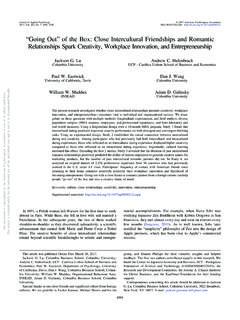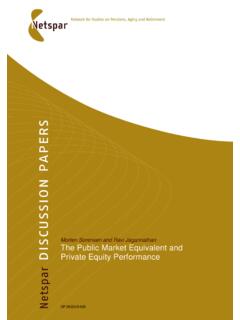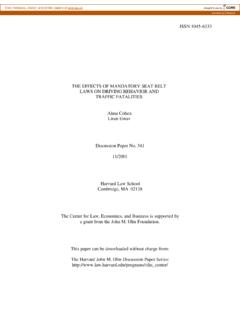Transcription of ISSN 1045-6333 HARVARD - Columbia Business School
1 Electronic copy available at: 1045-6333 HARVARD JOHN M. OLIN CENTER FOR LAW, ECONOMICS, AND Business PAYING FOR LONG-TERM PERFORMANCE Lucian A. Bebchuk and Jesse M. Fried Discussion Paper No. 658 12/2009, Revised 04/2010 HARVARD Law School Cambridge, MA 02138 This paper can be downloaded without charge from: The HARVARD John M. Olin Discussion Paper Series: The Social Science Research Network Electronic Paper Collection: This paper is also a discussion paper of the John M. Olin Center's Program on Corporate Governance Electronic copy available at: , University of Pennsylvania Law Review (2010) PAYING FOR LONG-TERM PERFORMANCE Lucian A. Bebchuk and Jesse M. Fried Abstract Firms, investors, and regulators around the world are now seeking to ensure that the compensation of public company executives is tied to long-term results, in part to avoid incentives for excessive risk taking.
2 This Article examines how best to achieve this objective. Focusing on equity-based compensation, the primary component of executive pay, we identify how such compensation should best be structured to tie pay to long-term performance. We consider the optimal design of limitations on the unwinding of equity incentives, putting forward a proposal that firms adopt both grant-based and aggregate limitations on unwinding. We also analyze how equity compensation should be designed to prevent the gaming of equity grants at the front end and the gaming of equity dispositions at the back end. Finally, we emphasize the need for the widespread adoption of limitations on executives use of hedging and derivative transactions that weaken the tie between executive payoffs and the long-term stock price that well-designed equity compensation is intended to produce.
3 Key words: executive compensation, executive pay, equity-based compensation, restricted shares, options, risk-taking, long-term, retention, backdating, spring-loading, unloading, insider trading, hedging, derivatives. JEL Classification: G28, K23 Friedman Professor of Law, Economics, and Finance and Director of the Program on Corporate Governance, HARVARD Law School . ** Professor of Law, HARVARD Law School . While Lucian Bebchuk served as a consultant to the Department of the Treasury Office of the Special Master on Executive Compensation, the views expressed in this paper (which was largely written prior to the beginning of Bebchuk s consulting appointment) do not necessarily reflect the views of the Office of the Special Master or any other individual affiliated with that Office.
4 For helpful discussions and comments, we would like thank Carr Bettis, John Cannon, Alma Cohen, Kenneth Feinberg, Brian Foley, Robert Jackson, Jon Lukomnik, Kevin Murphy, Nitzan Shilon, Holger Spamann, and participants at an NYU conference. Matt Hutchins provided valuable research assistance. For financial support, we are grateful to the IRRC Institute for Corporate Governance, the John M. Olin Center for Law, Economics, and Business , and the HARVARD Law School Program on Corporate Governance. The Article draws on chapters 14 and 16 of our book, Pay without Performance: The Unfulfilled Promise of Executive Compensation (2004), and shorter pieces written by one or both of us for The Economists Voice, the Journal of Applied Corporate Finance, the Wall Street Journal Online, and the HARVARD Business Review Online.
5 An earlier version of this Article was circulated in September 2009 under the title Reforming Executive Compensation. Electronic copy available at: TABLE OF CONTENTS I. TOWARD A REDESIGN OF EQUITY 1 II. LIMITATIONS ON UNWINDING EQUITY 5 A. Separating Vesting and Freedom to Unwind .. 6 B. The Problem with Retirement-Based Holding 9 C. Grant-Based Limitations on Unwinding .. 12 D. Aggregate Limitations on Unwinding .. 15 III. PREVENTING 21 A. The Front End .. 21 1. The Timing of Equity Grants .. 22 2. Stock Price Manipulation Around Equity 24 B. The Back 26 1. Gaming Problems at the Back-End .. 27 (a) Using Inside Information to Time Equity 27 (b) Stock-Price Manipulation Around 28 2. Addressing Gaming Problems at the Back End .. 29 (a) Average-Price 30 (b) The Need for Additional Steps.
6 32 (c) Pre-Trading 33 (d) Hands-Off 34 IV. LIMITATIONS ON HEDGING AND DERIVATIVE 36 V. 41 APPENDIX: PRINCIPLES FOR TYING EQUITY COMPENSATION TO LONG-TERM 43 I. TOWARD A REDESIGN OF EQUITY COMPENSATION In the aftermath of the financial crisis, regulators, firms, and investors are seeking to put executive pay arrangements in place that avoid rewarding executives for short-term gains that do not reflect long-term performance. This Article seeks to contribute to these efforts by analyzing how pay arrangements can and should best be tied to long-term performance. Our analysis focuses on equity-based compensation, the most important component of executive pay arrangements. In our 2004 book, Pay Without Performance: The Unfulfilled Promise of Executive Compensation, we warned that standard executive pay arrangements were leading executives to focus excessively on the short term, motivating them to boost short-term results at the expense of long-term The crisis of 2008 2009 has led to widespread recognition that pay arrangements that reward executives for short-term results can produce incentives to take excessive risks.
7 The importance of avoiding such flawed structures has been emphasized not only by leading public officials, such as Federal Reserve Chairman Ben Bernanke2 and Treasury Secretary Timothy Geithner,3 but also by top Business leaders such as Goldman Sachs s CEO Lloyd The recognition of the significance of the problem has led to substantial interest in fixing it. Treasury Secretary Geithner has urged corporate boards to pay top executives in ways that 1 See Lucian Bebchuk & Jesse Fried, Pay without Performance: The Unfulfilled Promise of Executive Compensation ch. 14 ( HARVARD Univ. Press 2004) (analyzing problems resulting from the broad freedom of executives to unload equity incentives); see also Richard Bernstein, Vindication for Critic of Pay, Int l Herald Trib.
8 , June 18, 2009, at 2, available at 2009 WLNR 11595028 (arguing that the analysis in our book was vindicated by the subsequent financial crisis). 2 See Ben S. Bernanke, Chairman, Bd. of Governors of the Fed. Reserve Sys., Speech at the Independent Community Bankers of America's National Convention and Techworld (Mar. 20, 2009), available at (declaring poorly designed compensation policies can create perverse incentives and that [m]anagement compensation policies should be aligned with the long-term prudential interests of the institution, be tied to the risks being borne by the organization, .. and avoid short-term payments for transactions with long-term horizons ). 3 See Press Release, Dep t of the Treasury, Statement by Treasury Secretary Tim Geithner on Compensation (June 10, 2009), available at (stating that compensation should be structured to account for the time horizon of risks ).
9 4 See Lloyd Blankfein, Do Not Destroy the Essential Catalyst of Risk, Fin. Times, Feb. 9, 2009, at 13 ( An individual's performance should be evaluated over time so as to avoid excessive risk-taking. ). 1are tightly aligned with the long-term value and soundness of the firm. 5 The TARP bill,6 subsequent legislation amending TARP,7 and the Treasury regulations implementing TARP8 all required the elimination of incentives to take unnecessary and excessive risks in firms receiving TARP funds. The Interim Final Rule on TARP Standards for Compensation and Corporate Governance, which appointed Kenneth Feinberg as the Special Master for TARP Executive Compensation, instructed Feinberg to focus on tying pay to long-term The Treasury s plan for financial regulatory reform called on federal regulators to issue standards for all financial firms to avoid excessive risks,10 and a bill recently passed by the House of Representatives requires regulators to adopt such In the meantime, regulators have been moving on their own in this direction.
10 The Federal Reserve Board requested comments on a proposed guidance contemplating the scrutiny of pay arrangements by banking supervisors,12 and the FDIC requested comments on a proposal to raise deposit insurance rates for banks whose compensation arrangements create excessive risk-taking 5 Press Release, Dep t of the Treasury, supra note 3. 6 See Emergency Economic Stabilization Act of 2008 111(b)(2), 12 5221(b)(2) (Supp. II 2009). 7 See American Recovery and Reinvestment Act of 2009, Pub. L. No. 111-5, sec. 7001, 111, 123 Stat. 115, 516-20 (amending section 111(b) of the Emergency Economic Stabilization Act). 8 See, , Press Release, Dep t of the Treasury, Treasury Announces New Restrictions on Executive Compensation (Feb. 4, 2009), available at (describing the Treasury guidelines promulgated under the Emergency Economic Stabilization Act).



















